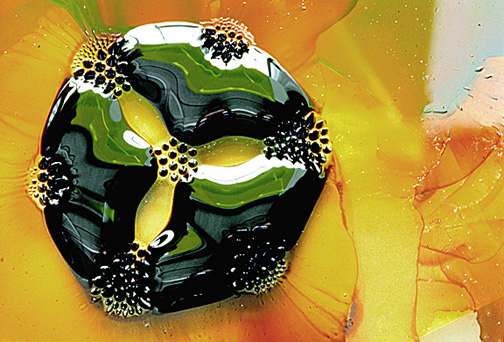 Ferrofluid on a glass surface, with 7 circular magnets. From On the Surface of Things, Images of the Extraordinary in Science by Felice Frankel and George M. Whitesides. (Image from web.mit.edu/feliceF/). |
Revelers at the APS Centennial gala hosted by the Fernbank Museum in Atlanta had the opportunity to view a new exhibit of work by renowned scientific photographer Felice Frankel. Frankel is currently artist in residence in science and technology and a research scientist in electrical engineering and computer science at the Massachusetts Institute of Technology (MIT). Her photographs, taken in collaboration with scientific researchers, have appeared on the covers and inside pages of such noteworthy publications as Nature, Science, the Journal of Physical Chemistry, and Cellular Biology, as well as a number of MIT publications.
Constructed around the theme of "Envisioning Physics," Frankel's Fernbank exhibit was commissioned by the APS specifically for the Centennial meeting. Like most of Frankel's work, the photographs are spare, composed of three-dimensional forms and structures recorded on two dimensions, and carefully focused upon the particular point of scientific investigation. "For me, form, shape and composition are integral to a scientific image," she says of her work. "I compose data, making it readable and comprehensible, and the scientists with whom I work agree that visually clarified information adds another dimension to the exchange of ideas."
Frankel earned her undergraduate degree in biology and worked as a laboratory assistant at Columbia University, conducting research on subcellular systems before leaving to raise a family. She subsequently established a solid reputation as a photographer of landscapes and architecture, eventually publishing a book entitled Modern Landscape Architecture. Her success resulted in her being awarded a Loeb fellowship from Harvard University's Graduate School of Design, giving her the freedom to pursue any course of study she desired in 1991, at the age of 47. While her colleagues in the program opted for the usual architecture and design courses, Frankel found herself rediscovering her passion for science, taking classes with E.O. Wilson and Stephen J. Gould, among others.
The turning point came when she audited a course with George Whitesides, a professor of chemistry who presented lectures "in a very imaginative and visual way," says Frankel. Intrigued enough to want to work in his laboratory, she introduced herself, and he offered her the opportunity to come up with a photograph to accompany an article he'd submitted to Science magazine. The image she created wound up gracing the cover, and with Whiteside's continued support and encouragement, she found herself embarked on an entirely new career: science photography.
"It was one of the those unbelievably serendipitous situations," she now says. "If I had started with another research group, this probably might not have happened." In 1997 she coauthored a book with Whitesides, entitled On The Surface of Things: Images of the Extraordinary in Science (Chronicle Books), based on an exhibit of the same title which is presently traveling around the country.
A strong proponent of the importance of the visual element in communicating science to a broader public, Frankel is dedicated to providing researchers and students of science alike with "a visual vocabulary" of science. "Too often the visual beauty of scientific research seems to be kept secret," she says. "Scientists are trained to be suspicious of visually stunning displays, often dismissing them as unnecessary or superficial, and thus remain largely unaware of the value of the visual poetry of their own work."
To this end, Frankel has received a grant from the National Science Foundation to develop a guidebook for students and researchers on how to incorporate powerful visual images into the communication of their data. "It's literally a how-to recipe book," she says, crossing all spectra of the various fields of research. Along with several colleagues, she is also organizing a major conference on envisioning science and technology, to be held at MIT in June 2001.
The conference, entitled "Image and Meaning" will gather together researchers in all disciplines, as well as journal editors, art directors, science and biomedical imagers, photographers, illustrators, animators, museum exhibitors, writers, and TV and film producers - anyone involved in the visual presentation of science to the general public.
The unique process by which Frankel creates her own images is decidedly collaborative in nature. She meets with willing researchers, learns as much as she can about their work, and uses their input to create an image that captures the essence of the research. However, she balks at elevating her photographs to the level of art. "I do not view myself as an artist because an artist has a personal agenda and a very particular point of view, that of communicating the part of herself she wants the world to perceive," she says, adding that the primary purpose of her images is to communicate scientific information. "To suggest that art and science are related may dangerously redefine each. Scientific images may be beautiful and even artistic, but they are not art, and art is not science."
An online version of Felice Frankel's exhibit, "Envisioning Physics," is at http://web.mit.edu/feliceF/www/aps1.html. In addition, the entire exhibit is available for touring at select venues around the country. Interested parties should contact Frankel directly at felicef@mit.edu, or (617) 253-5604.
©1995 - 2024, AMERICAN PHYSICAL SOCIETY
APS encourages the redistribution of the materials included in this newspaper provided that attribution to the source is noted and the materials are not truncated or changed.
Editor: Barrett H. Ripin
Associate Editor: Jennifer Ouellette
May 1999 (Volume 8, Number 5)
Articles in this Issue

